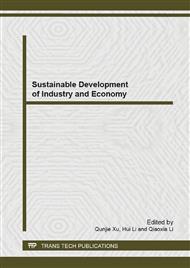[1]
Jinhe Zhang, Jie Zhang, Yuelin Liang et al. An analysis of touristic ecological footprint and eco-compensation of Jiuzhaigou in 2002. Journal Of Natural Resources. Vol 20, pp.735-744, September 2005 (In Chinese).
Google Scholar
[2]
Schaltegger S, Sturm A. Ökologische rationalität. die Unternehmung, 4(90), 1990, pp.273-290.
Google Scholar
[3]
Schmidheiny S. Changing Courses: A Global Business Perspective on Development and the Environment. Executive summary. MIT press, (1992).
Google Scholar
[4]
Organisation for Economic Co-operation and Development. Eco-efficiency. OECD, 1998, pp.7-11.
Google Scholar
[5]
Australian Government: Department of the Environment and Heritage. http: /www. deh. gov. au.
Google Scholar
[6]
European Environmental Agency. Making sustainability accountable: Eco-efficiency, resource productivity and innovation. http: / glossary. eea. eu. int.
Google Scholar
[7]
International Finance Corporation. http: /www. ifc. org/ifcext/enviro. nsf/Content/CleanerProduction.
Google Scholar
[8]
United Nations Conference on Trade and Development. Integrating Environmental and Financial Performance at the Enterprise level: A methodology for standardizing Eco-efficiency Indicators. United Nations Publication, 2003, pp.29-30.
Google Scholar
[9]
Schmidheiny S, Stigson B. Eco-efficiency: creating more value with less impact. World Business Council for Sustainable Development, (2000).
Google Scholar
[10]
Krikke H, Bloemhof-Ruwaard J, Van Wassenhove L N. Concurrent product and closed-loop supply chain design with an application to refrigerators. International Journal of Production Research, 41(16), 2003, pp.3689-3719.
DOI: 10.1080/0020754031000120087
Google Scholar
[11]
Frota Neto J Q, Bloemhof-Ruwaard J M, Van Nunen J, et al. Designing and evaluating sustainable logistics networks. International Journal of Production Economics, 111(2), 2008, pp.195-208.
DOI: 10.1016/j.ijpe.2006.10.014
Google Scholar
[12]
Cook W D, Seiford L M. Data envelopment analysis (DEA)–Thirty years on. European Journal of Operational Research, 192(1), 2009, pp.1-17.
DOI: 10.1016/j.ejor.2008.01.032
Google Scholar
[13]
Vogtländer J G, Bijma A, Brezet H C. Communicating the eco-efficiency of products and services by means of the eco-costs/value model. Journal of Cleaner Production, 10(1), 2002, pp.57-67.
DOI: 10.1016/s0959-6526(01)00013-0
Google Scholar
[14]
Almeida C, Rodrigues A J M, Bonilla S H, et al. Emergy as a tool for Ecodesign: evaluating materials selection for beverage packages in Brazil. Journal of Cleaner Production, 18(1), 2010, pp.32-43.
DOI: 10.1016/j.jclepro.2009.03.019
Google Scholar
[15]
Suh S, Lee K M, Ha S. Eco‐efficiency for Pollution Prevention in Small to Medium‐Sized Enterprises: A Case from South Korea. Journal of Industrial Ecology, 9(4), 2005, pp.223-240.
DOI: 10.1162/108819805775247918
Google Scholar
[16]
Côté R, Booth A, Louis B. Eco-efficiency and SMEs in Nova Scotia, Canada. Journal of Cleaner Production, 14(6), 2006, pp.542-550.
DOI: 10.1016/j.jclepro.2005.07.004
Google Scholar
[17]
Van Berkel R. Cleaner production and eco-efficiency initiatives in Western Australia 1996–2004. Journal of Cleaner Production, 15(8), 2007, pp.741-755.
DOI: 10.1016/j.jclepro.2006.06.012
Google Scholar
[18]
Maxime D, Marcotte M, Arcand Y. Development of eco-efficiency indicators for the Canadian food and beverage industry. Journal of Cleaner Production, 14(6), 2006, pp.636-648.
DOI: 10.1016/j.jclepro.2005.07.015
Google Scholar
[19]
P Picazo-Tadeo A J, Gómez-Limón J A, Reig-Martínez E. Assessing farming eco-efficiency: A Data Envelopment Analysis approach. Journal of environmental management, 92(4), 2011, pp.1154-1164.
DOI: 10.1016/j.jenvman.2010.11.025
Google Scholar
[20]
Gössling S, Peeters P, Ceron J P, et al. The eco-efficiency of tourism. Ecological economics, 54(4), 2005, pp.417-434.
DOI: 10.1016/j.ecolecon.2004.10.006
Google Scholar
[21]
Kelly J, Haider W, Williams P W, et al. Stated preferences of tourists for eco-efficient destination planning options. Tourism Management, 28(2), 2007, pp.377-390.
DOI: 10.1016/j.tourman.2006.04.015
Google Scholar
[22]
Reilly J, Williams P, Haider W. Moving towards more eco-efficient tourist transportation to a resort destination: The case of Whistler, British Columbia. Research in Transportation Economics, 26(1), 2010, pp.66-73.
DOI: 10.1016/j.retrec.2009.10.009
Google Scholar
[23]
Bin Yang. Research on regional eco-efficiency of China from 2000 to 2006—an empirical analysis based on DEA. Economic Geography. Vol 29, pp.1197-1202, July 2009 (In Chinese).
Google Scholar
[24]
Huijuan Li, Ruyin Long, Xinpin Lan. Assessment for eco-efficiency of resource-based cities. Resource Science. Vol 29, pp.1296-1300, July 2010 (In Chinese).
Google Scholar
[25]
Ruiling Han, Lianjun Tong, Yanan Song. Analysis of circular economy of Liaoning province based on eco-efficiency. Acta Ecological Sinica, Vol 31, pp.4732-4740, August 2011 (In Chinese).
Google Scholar
[26]
Jinhe Zhang, Measuring the ecological impacts of tourism wastes: methodology and cases study of Jiuzhaigou and Huangshan National Park. Acta Ecological Sinica, Vol 28, pp.2764-2773, June 2008 (In Chinese).
Google Scholar


